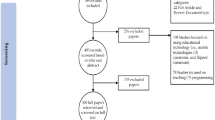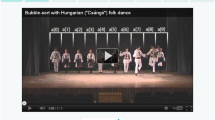Abstract
Digital literacy is a need for our current society. In Mexico, digital incursion programs are barely implemented, which represents an educational delay compared to other countries that have faced the need to integrate the teaching of digital skills, in a wide range of educational levels. This paper presents a learning environment of Computational Thinking called EasyLogic3D, which proposes a novel integration of emotional recognition, gamification, and a 3D environment. Experiments with 102 children from an Elementary School in Mexico were carried out, where cognitive and technological acceptance tests were performed. Analyzing the Cronbach’s alpha score, we found that students accepted the technology (learning environment). Also, the results showed that the perceived enjoyment when using the learning environment was positive. On the other hand, results show that the learning gained through using the learning environment was comparable to a class session in which the same topics and exercises were presented.




Similar content being viewed by others
References
Abdullah, F., & Ward, R. (2016). Developing a general extended technology acceptance model for E-learning ( GETAMEL ) by analysing commonly used external factors. Computers in Human Behavior, 56, 238–256. https://doi.org/10.1016/j.chb.2015.11.036.
Arawjo, I., Wang, C., Myers, A. C., Andersen, E., & Guimbretière, F. (2017). Teaching programming with Gamified semantics. In Proceedings of the 2017 CHI Conference on Human Factors in Computing Systems, 4911–4923.
Balanskat, A., & Engelhardt, K. (2015). Computing our future. Computer Programming and Coding Priorities, School Curricula and Initiatives across Europe. European Schoolnet, 87.
Barcelos, T. S., Munoz, R., Villarroel, R., Merino, E., & Silveira, I. F. (2018). Mathematics learning through computational thinking activities: A systematic literature review. Journal of Universal Computer Science, 24(7), 815–845.
Bers, M. U., Flannery, L., Kazakoff, E. R., & Sullivan, A. (2014). Computational thinking and tinkering: Exploration of an early childhood robotics curriculum. Computers in Education, 72, 145–157. https://doi.org/10.1016/j.compedu.2013.10.020.
Bocconi, S., Chioccariello, A., Dettori, G., Ferrari, A., Engelhardt, K., Kampylis, P., & Punie, Y. (2016). Developing computational thinking in compulsory education – Implications for policy and practice. In EUR 28295 EN; https://doi.org/10.2791/792158.
Brennan, K., & Resnick, M. (2012). New frameworks for studying and assessing the development of computational thinking. Annual American Educational Research Association Meeting, Vancouver, BC, Canada, 1–25. Retrieved from http://web.media.mit.edu/~kbrennan/files/Brennan_Resnick_AERA2012_CT.pdf
Cárdenas Peralta, M. C., & Argüello Maya, E. (2017). Programa @prende 2.0 Inclusión de niñas y niños con discapacidad a través de las TIC, 2017 (Vol. 0).
Conde, M. Á., Fernández-Llamas, C., Rodríguez-Sedano, F. J., Guerrero-Higueras, Á. M., Matellán-Olivera, V., & García-Peñalvo, F. J. (2017). Promoting computational thinking in K-12 students by applying unplugged methods and robotics. Proceedings of the 5th international conference on technological ecosystems for enhancing Multiculturality - TEEM 2017, 1–6. https://doi.org/10.1145/3144826.3145355.
Csizmadia, A., Curzon, P., Dorling, M., Humphreys, S., Ng, T., Selby, C., & Woollard, J. (2015). Computational thinking - a guide for teachers. Computing At School, (January).
Denning, W. F. (2016). Remixing as a pathway to computational thinking. In Proceedings of the 19th ACM Conference on Computer-Supported Cooperative Work & Social Computing, 1438–1449. https://doi.org/10.1002/asna.19011561807.
Dicheva, D., Dichev, C., Agre, G., & Angelova, G. (2015). Gamification in education : A systematic mapping study. Journal of Educational Technology & Society, 18(3), 1–14.
Falk, G., & Mannock, K. L. (2018). First steps in creative computational thinking with natural language programming and Lego M INDSTORMS. In proceedings of the international conference on E-learning, e-business, Enterprise information systems, and e-government (EEE) (Pp. 10–16), 10–16.
Freitas, S. D. (2018). Are games effective learning tools ? A review of educational games the review : A recent history of game science. Journal of Educational Technology & Society, 21(2), 74–84.
Granic, A., & Marangunic, N. (2015). Technology acceptance model : A literature review from 1986 to 2013. Universal Access in the Information Society, 14(1), 81–95. https://doi.org/10.1007/s10209-014-0348-1.
Grover, S., & Pea, R. (2015). Reviews / Essays Computational Thinking in K – 12 : A Review of the State of the Field. Educational Researcher, 42(1), 38–43. https://doi.org/10.3102/0013189X12463051.
Hamari, J., & Sarsa, H. (2014). Does Gamification work? — A literature review of empirical studies on Gamification. In Proceedings of the 47th Hawaii International Conference on System Sciences. https://doi.org/10.1109/HICSS.2014.377.
INEE. (2019). La Educación Obligatoria En México Informe 2019. Retrieved September 20, 2012, from https://www.inee.edu.mx/medios/informe2019/stage_01/tem_05.html
Kahn, K., Megasari, R., Piantari, E., & Junaeti, E. (2018). AI programming by children using snap ! Block programming in a developing country. Thirteenth European Conference on Technology Enhanced Learning, 2018, 1–14.
Kazimoglu, C., Kiernan, M., Bacon, L., & MacKinnon, L. (2012). A serious game for developing computational thinking and learning introductory computer programming. Procedia - Social and Behavioral Sciences, 47, 1991–1999. https://doi.org/10.1016/j.sbspro.2012.06.938.
Kumar, R. (2019). Face detection and tracking: Using OpenCV. In 2017 International Conference of Electronics, Communication and Aerospace Technology (ICECA), (1), 474–478. https://doi.org/10.1109/ICECA.2017.8203730.
Li, S., & Deng, W. (2018). Deep facial expression recognition: A survey. IEEE Transactions on Affective Computing, 1–25. Retrieved from http://arxiv.org/abs/1804.08348
Lockwood, J., & Mooney, A. (2017). Computational thinking in education: Where does it fit? A systematic literary review. ArXiv Preprint ArXiv:1703.07659., (march).
Nicholson, S. (2015). A RECIPE for meaningful Gamification. In Gamification in Education and Business, 1–20.
Politou, E., Alepis, E., & Patsakis, C. (2017). A survey on mobile affective computing. Computer Science Review, 25, 79–100. https://doi.org/10.1016/j.cosrev.2017.07.002.
Resnick, M., Maloney, J., Monroy-Hernández, A., Rusk, N., Eastmond, E., Brennan, K., Millner, A., Rosenbaum, E., Silver, J., Silverman, B., & Kafai, Y. (2009). Scratch: Programming for all. Communications of the ACM, 52, 60–67. https://doi.org/10.1145/1592761.1592779.
Seaborn, K., & Fels, D. I. (2014). Gamification in theory and action: A survey. International Journal of Human Computer Studies, 74, 14–31. https://doi.org/10.1016/j.ijhcs.2014.09.006.
Shute, V. J., Sun, C., & Asbell-Clarke, J. (2017). Demystifying computational thinking. Educational Research Review, 22, 142–158. https://doi.org/10.1016/j.edurev.2017.09.003.
Sullivan, F. R., & Heffernan, J. (2016). Robotic construction kits as computational manipulatives for learning in the STEM disciplines. Journal of Research on Technology in Education, 48(2), 105–128. https://doi.org/10.1080/15391523.2016.1146563.
Taheri, S., Veidenbaum, A., & Haghighat, M. R. (2017). OpenCV . js : Computer Vision Processing for the Web.
Tan, A. J. Q., Lee, C. C. S., Lin, P. Y., Cooper, S., Lau, L. S. T., Chua, W. L., & Liaw, S. Y. (2017). Designing and evaluating the effectiveness of a serious game for safe administration of blood transfusion: A randomized controlled trial. Nurse Education Today, 55, 38–44. https://doi.org/10.1016/j.nedt.2017.04.027.
To, W., Lai, L. S. L., & Leung, V. W. S. (2019). Technology acceptance model for the intention to use advanced business application software among Chinese business school students. Australasian Journal of Educational Technology, 35(4), 160–173.
Tsarava, K., Moeller, K., Pinkwart, N., Butz, M., Trautwein, U., Ninaus, M., & Institut, L. (2017). Training computational thinking : Game-based unplugged and plugged-in activities in primary school training computational thinking : Game-based unplugged and plugged-in activities in primary school. In European Conference on Games Based Learning, 687–695. Academic Conferences International Limited.
Vogel, S. (2019). Power, Discourse, and knowledge in computer science education advocacy: An analysis of popular Code.org videos. Power & Discourse in Computer Science Education. https://doi.org/10.31235/osf.io/rz9gw
What will you create? | Code.org. (2019). Retrieved August 27, 2019, from https://code.org/
Wing, J. M. (2006). Computational thinking CS @ CMU and grand vision for the field. Communications of the ACM, 49(3), 33–35.
Witten, H., Adams, R., Mckenzie, J., Bell, T., Witten, I. H., & Fellows, M. (2015). An enrichment and extension programme for primary-aged children an enrichment classroom use by. In Computer Science Unplugged (csunplugged. org).
Yadav, A., Mayfield, C., Zhou, N., Hambrusch, S., & Korb, J. T. (2014). Computational thinking in elementary and secondary teacher education. ACM Transactions on Computer Systems, 14(1), 1–16. https://doi.org/10.1145/2576872.
Zatarain, R., Hector, C., Rangel, R., Manuel, H., Lopez, C., Lucia, M., & Estrada, B. (2019). Hyperparameter optimization in CNN for learning-centered emotion recognition for intelligent tutoring systems. Soft Computing, 1–10. https://doi.org/10.1007/s00500-019-04387-4.
Author information
Authors and Affiliations
Corresponding author
Ethics declarations
Conflict of interest
Not applicable.
Ethics approval
Not applicable.
Consent to participate
A text document was provided to both students (participants) and their parents, summarizing the purpose of the research and their right to withdraw at any moment.
Consent for publication
All authors agree with the publication.
Code availability
Not applicable.
Additional information
Publisher’s note
Springer Nature remains neutral with regard to jurisdictional claims in published maps and institutional affiliations.
Rights and permissions
About this article
Cite this article
Ríos Félix, J.M., Zatarain Cabada, R. & Barrón Estrada, M.L. Teaching computational thinking in Mexico: A case study in a public elementary school. Educ Inf Technol 25, 5087–5101 (2020). https://doi.org/10.1007/s10639-020-10213-4
Received:
Accepted:
Published:
Issue Date:
DOI: https://doi.org/10.1007/s10639-020-10213-4




